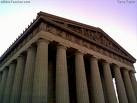 It puzzles me that certain Biblical passages that by some are categorized as doubtful in their origins, at least from the angle of textual criticism (primarily), such as the end of Mark 16 and the beginning of John 8, are not being dealt with fairly being subjected to the study of textual criticism only while they ought to share equally in other fields of study, such as the historical studies related to succession and transmission.
It puzzles me that certain Biblical passages that by some are categorized as doubtful in their origins, at least from the angle of textual criticism (primarily), such as the end of Mark 16 and the beginning of John 8, are not being dealt with fairly being subjected to the study of textual criticism only while they ought to share equally in other fields of study, such as the historical studies related to succession and transmission.For examples, it appears, that the earliest text of Mark's Gospel utilized in Alexandria, on which the Alexandrian family tends to rest, omitted the end of Mark found in the Western and Byzantine manuscripts.
Considering the writings of e.g. Clement of Alexandria this particular version of Mark was written prior to the death of Peter. While according to Irenaeus, the disciple of Polycarp, (who was) the disciple of John the apostle and John the Elder, the text of Mark commonly recognised in the West by the Latin fathers and including Irenaeus and probably Polycarp, in both Greek and Latin language, arrived after the death of Peter and contained the ending.
Some textual critics mistakenly brush aside the original validity of the ending and deduce from textual methods only that these are later interpolations, included either by the community or a scribe.
I fully understand and agree with this conclusion if I would approach the passage from the angle of textual criticism only (and that is a fallacy).

Yet, this conclusion only states that the earliest Mark did not contain the ending, it does not adduce the idea of Markan or apostolic absense, nor are we in a position based upon textual criticism able to conclude that the passage is not valid as original Gospel transmission. Hence the earliest Mark was probably a proto-Mark (a Mark that lacked the ending) when considering that the end of Mark was lacking. Some critics of the Christian faith wrongly assume that this presents a difficulty, while in fact Christians have no difficulties with proto-Gospels, since the Gospels are the recordings of apostles and their disciples based upon oral transmission under the control of apostolic successors.
Hence these written works could be and probably were improved and edited by additional transmission, yet under an apostolic control (notice: I am not referring to textual variants within textual criticism but the formation of the actual source).
Given that the field of background study and historical study needs to be considered. It is likely that Mark, the disciple of the apostle Peter, himself derived in Alexandria with the earliest Gospel of Mark 55 AD or even earlier (according to early Christian tradition) only 20-25 years after the resurrection of Jesus Christ (this version of Mark did not contain the longer ending of Mark).
Yet despite of this date, the conclusion of some textual critics still does not refute the possibility that Mark was responsible for a proto-Mark which omitted the ending and later another version of Mark that contained it. Contrary to popular opinion the style of writing which differentiates the longer ending of Mark and the major body of the text does not refute this, since Mark's Gospel is Mark's recording of Peter's personal transmission of the Gospel account and hence Peter's style of wording. While the end of Mark could well present the style, not of Peter, but the scribe (that is Mark).
On the other hand, it is possible indeed that the end of Mark was never recorded by Mark; does this render the text reliable or external?
Not really!
Is the Gospel of Mark a Gospel because it contains Mark's transmission of Peter only or because it contained general apostolic transmission and tradition (that is Peter's transmission and additional transmission)?
In that case the end of Mark, may present Mark's recording of Peter's transmission, but not the transmission conveyed in the sammer as in the rest of Mark, yet still transmission and possibly even transmission conveyed by Peter. Here it is possible indeed that Mark simply summarized the transmission of Peter.
We may also conclude that the end of Mark if not being Mark's recording, neverthless conveys to us Gospel transmission that flourished among the Christians under the control of apostolic successors no less than 20-30 years after the death, resurrection and ascension of Jesus and hence the end of Mark 16 is correctly to be deemed Christian Scripture.
In that case the end of Mark 16 may not correctly be rendered 'transmission recorded by Mark' but nevertheless in its correct nature and category still 'Gospel transmission'.






